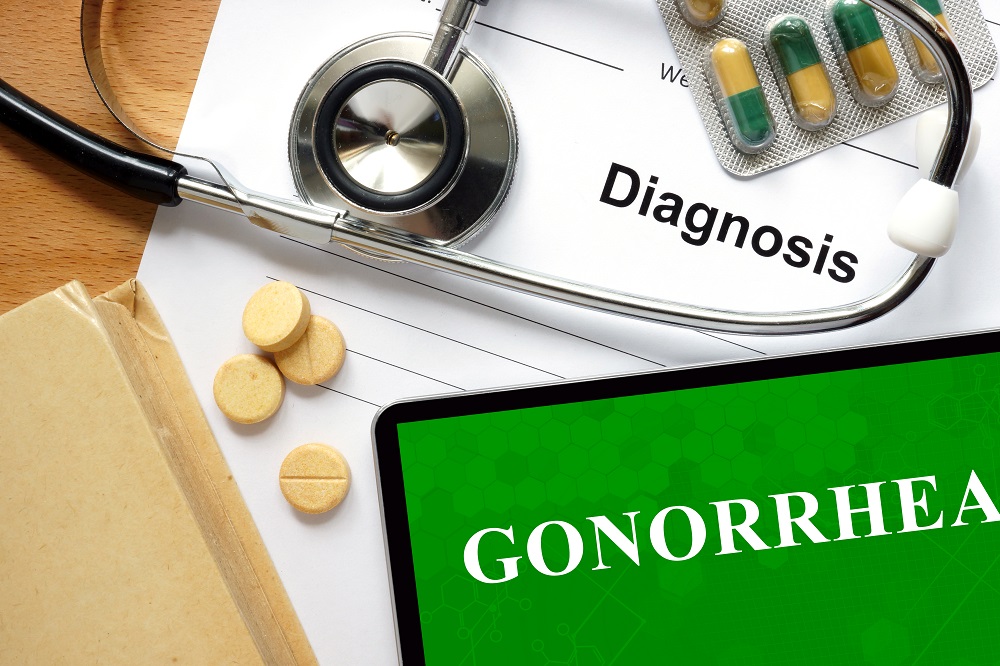Very often, gonorrhea causes no symptoms. In case symptoms appear (within two to 10 days after exposure, but sometimes only after a month) the infection can affect multiple sites in the body, but it usually occurs in the genital tract.
Symptoms of gonorrhea in men:
- Pain during urination
- Pus-like discharge from the tip of the penis
- Swelling in one testicle
- Pain in one testicle
Symptoms of gonorrhea in women:
- Pain during urination
- Increased vaginal discharge
- Pelvic pain
- Vaginal bleeding (e.g. after vaginal intercourse)
- Lower abdominal pain
- Spotting after intercourse
- Swelling of the vulva
Gonorrhea may also affect:
- Eyes: eye pain, sensitivity to light, and pus-like discharge from one or both eyes
- Throat: sore throat and swollen lymph nodes in the neck
- Joints: warm, red, swollen and extremely painful joints, especially while moving the joint
- Rectum: anal itching, pus-like discharge, bright red blood, strenuous bowel movements
In men, these symptoms normally appear two to 14 days after infection. In some women, symptoms go unnoticed.
Gonorrhea is caused by the bacterium Neisseria gonorrhoeae. It’s mostly passed from person to person during oral, anal or vaginal intercourse. The bacteria can grow in the warm, moist areas of the reproductive tract, i.e. in the uterus, cervix, fallopian tubes in women, in the urethra in women and men, as well as in the mouth, throat, and anus.
In general, women are at greater risk of long-term complications from untreated infections, e.g. if they develop scarring of the fallopian tubes that can prevent future pregnancy. Gonorrhea can also result in pelvic inflammatory disease which sometimes involves ongoing pelvic pain, ectopic pregnancy and infertility. The infection may be passed to a newborn baby during delivery.
In men, gonorrhea might cause a painful abscess in the interior of the penis, or scarring of the urethra. Very seldom, the infection spreads to the bloodstream which results in arthritis, heart valve damage, or inflammation of the lining of the brain or spinal cord – a serious condition that can affect both men and women.
Tests for Gonorrhea
- Urine test to identify bacteria in the urethra
- Swab of affected area, such as throat, urethra, vagina or rectum in order to identify bacteria in a laboratory
Treatment
Most of the time, it’s possible to cure gonorrhea infection with antibiotics. Doctors usually give an injection of strong antibiotic upon diagnosis. A follow-up test might be necessary to make sure the infection has cleared up. However, some strains of gonorrhea have developed resistance to common antibiotics. These affected patients require more extensive treatment or combinations of antibiotics. Researchers are already working on vaccines that prevent gonorrhea.
When a person has been infected with gonorrhea, his/her partner must also be treated: The “Ping pong” effect of reinfection will cease only when the couple is treated simultaneously.
Preventive measures
The risk of gonorrhea can be reduced by:
- Using a condom during any type of sexual contact (anal sex, oral sex, vaginal sex)
- Asking the partner to be tested for sexually transmitted infections
- Avoiding sex with someone who shows unusual symptoms, such as burning during urination, genital sore or rash
- Having regular gonorrhea screening in case of an increased risk (e.g. gonorrhea or other sexually transmitted infections in the past, a new sex partner, multiple sex partners)


